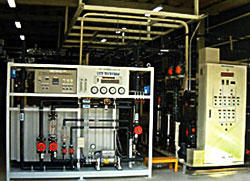Outline of Ultrapure Water System
System overview
The stack at the heart of the system consists of alternating cation and anion exchange membranes, with ion exchange resins filling the spaces between the membranes. The stack has electrodes at both ends and is structured to apply DC voltage.
Features
- It is capable of continuous production of purified water with a specific resistivity of 10 MΩ·cm or higher.
- Because it is electrically regenerated, no regeneration chemicals are required.
- The concentrate can be reused.
- Easy operation management and maintenance.
- It is capable of reducing running costs compared to conventional ion exchange methods.
- Because of its unit design, it also facilitates space savings.
Desalination treatment
Ions contained in the supplied water are adsorbed by the ion exchange resins and move on the resin surface under DC current.
Anions are discharged into the concentrated water after passing it through the anion exchange membrane and cations after passing it through the cation exchange membrane.
It produces desalinated water while continuously regenerating the ion exchange resins.
Example of ultrapure water system
While the system configuration varies depending on the raw water quality and the required water quality, a representative example is shown below.

Applications
- Cleaning water for semiconductors and electronic components
- Water supply for cogeneration
- Cleaning water for solar cell panels
- Boiler water
- Water for cosmetic products
- Water for food, beverage, and brewing
- Service water for lens, plating, painting, and precision machinery
- Service water for medical and pharmaceutical purposes
- Service water for other miscellaneous manufacturing

